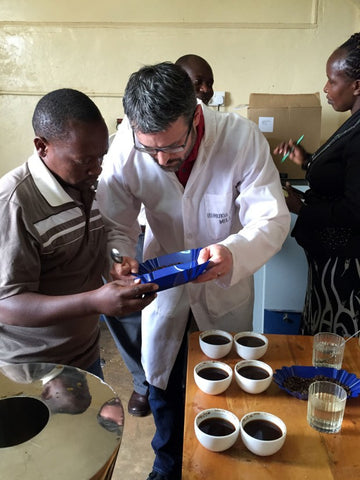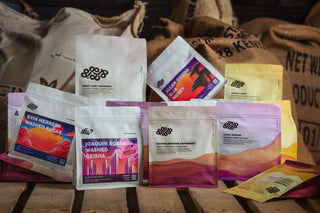By Phil
My trip to Kenya two weeks ago, for this year’s harvest, was anything but simple. Last year, we experienced some arrival quality problems with our coffees, and we were forced to reject some of the lots. This was very unfortunate, and something that I hate doing. I know that it puts an exporter in the difficult position of finding a new home for the coffee (i.e. usually at a loss) and it certainly puts strain on our relationship! That said we experience the same issue on our end as well, whether it be a wholesale customer that has an issue, or a retail customer that’s unhappy with their coffee. To stand behind our product, we need to be ready to absorb the cost and make amends to ensure that our customers associate us with the highest quality. In fact, we usually stop problem product at the door. Many years ago, our waste at the café was astronomical—literally 20% of drinks never made it into customers’ hands. Thankfully, through better preemptive quality control measures, this has come down significantly. Nevertheless, maintaining high standards of quality requires some product loss.
But I digress…back to Kenya.
Naturally, this season my primary directive was to make sure that the damage mentioned above did not happen again. Based on my extensive testing last year, I concluded that the coffee had reabsorbed moisture due to prolonged storage in high humidity conditions. This was the culprit for the premature aging and quality degradation that our coffees had experienced. I diagnosed this issue using something called water activity. In our case, the water activity of our coffees had spiked, but their water content (% moisture) had only changed slightly. This tells me that the coffee reabsorbed moisture from humid air after it was already fully dry, as the new water was residing on the outer layer of the bean.
All that water in the high-humidity air is sucked into the green coffee like a sponge, and it causes two majors issues: the green coffee bean, which is actually a seed, will leave its dormant state and kick-off the germination process. This will consume its sugars along with a lot of the good flavour characteristics of the coffees. As if that’s not enough, if the water activity exceeds 0.6, then micro bacteria will grow. This is also bad for flavor, and one’s health!
Ok, hopefully I haven’t put you to sleep with all the geekery. The bottom line is that while rain is the great friend of coffee trees, it is the mortal enemy of coffee after it has left the tree. But in the case of Kenya, the real issue is climate change.
My observation is that all of the systems in Kenya are based around the historically highly predictable wet and dry seasons. But this is changing. Last year, I experienced torrential downpours during my trip in February, the typically hottest and driest month of the year. So you can imagine my dread when I landed on February 7th this year to cloudy skies and heavy rain. In fact, I didn’t see the sun for the entire week! This year, Kenya has El Niño to thank for even more unpredictable weather. Rain, rain and more rain—during the dry season. My air-conditioned room was 70% relative humidity. I feared greatly for all of the unprotected green coffee in warehouses I visited.
Despite this potential for damage, to my knowledge, there are no humidity-controlled warehouses in Nairobi. The storage problem is further exasperated in Kenya compared to other origins. The irony is that the sophisticated auction system that Kenya uses, which is the envy of every other African country, is a major contributor to quality loss. Coffee mills and co-ops sell the majority of their coffee through this auction process. While the auction might be great for fetching a higher price, the process introduces long (sometimes by months) delays. During the time, the coffee has already been milled and it’s just sitting in the open air, potentially reabsorbing moisture from humid air, and slowly degrading. Thankfully, there are ways to bypass the auction and buy directly, which greatly speeds up the process. This coffee is stored already milled (in green form) for sometimes months as well.
I cupped many spectacular coffees during my visit this year, but most of the coffees I tested for moisture and water activity were well on their way to being damaged. I felt helpless against it. Well, almost helpless. I had a number of very fruitful conversations with forward-thinking individuals such as Phyllis from Kenya Coffee Cooperative Exporters (KCCE). She took the time to sit down with me and take to heart some of my concerns for the wellbeing of our coffee and all the coffee they sold. This was a big deal for me, as she’s an extraordinarily busy lady. See her pictured below multitasking on the phone during one of our many meetings. Phyllis truly cares about the wellbeing of the coffee farmers she represents, and it’s inspiring!

During my visit, I also headed upcountry to visit the Nyeri region. Specifically, I visited a new dry mill owned by the Rumukia co-op, the society behind one of my perennial favourite coffees from the Kiawamururu factory. I was impressed. It’s early days, but their operations are very well run. See the below picture of me in their cupping lab. We talked about roasting and cupping protocols, and they were eager to learn and improve. Music to my ears!

The other place that I was excited to visit (for the first time) was the Othaya Farmers Cooperative Society. The co-op represents 19 wet mills officially, but this season, due to a lower volume of cherry, a few of the smaller wet mills didn’t operate and their members’ cherry was brought to larger neighbouring mills. They had a great little cupping lab at Othaya, and I spent a few hours there tasting some extraordinary coffees -some of my favourites of the trip, for sure! Look for Othaya coffees on our menu this season! Naturally, before departing, I had to take the obligatory staged photo with some Othaya board members as well as their mill operator and my co-visitor from KCCE. The folks from Othaya were very welcoming and accommodating, and I immediately got the impression that they were sophisticated, long-term thinkers who will continue to be key innovators in the Nyeri region.

All in all it was a fruitful trip. Even though the storage of coffee in Kenya worsens, I’m hopeful that real change is imminent, and I’m very happy with our selections for this season!
- Phil







